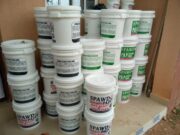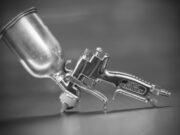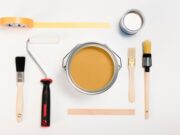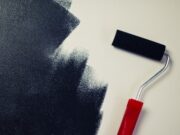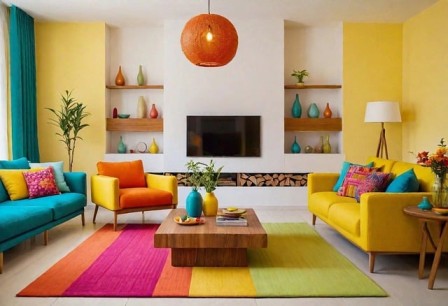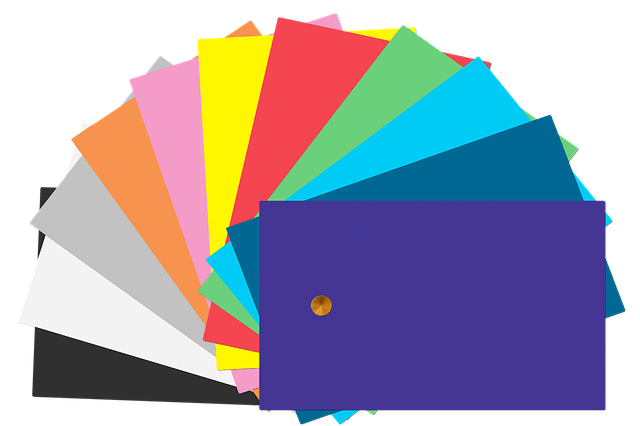Interior design is more than just arranging furniture and picking out decorative pieces.
One of the most powerful, yet often underestimated, elements of interior design is color.
Paint color has the power to transform a space, not only visually but psychologically. It can evoke emotions, influence moods, and even affect behavior.
This is where the psychology of paint color in interior design becomes a critical component for both designers and homeowners alike.
In this article, we will explore how color affects our psychology and the meanings and effects of individual colors.
We will also explore how to apply this knowledge in different rooms and some expert tips on achieving the perfect balance in any space.
What Is Color Psychology?
Color psychology is the study of how different hues impact human behavior, feelings, and perceptions.
The theory is based on the idea that colors can stimulate emotional responses and can even influence physiological states such as appetite, blood pressure, and energy levels.
While reactions to color can be subjective and culturally influenced, there are widely accepted psychological associations for most colors.
These associations are often used in branding, marketing, art therapy, and, of course, interior design.
Understanding the psychology of paint color in interior design helps you to create environments that support desired moods or activities.
For example, calming colors might be used in a bedroom to promote rest, while energizing colors are better suited for a gym or office space.
The Emotional Impact of Some Specific Colors
Let’s take a look at some commonly used colors in our daily interior design and the emotions or behaviors they tend to evoke.
1. Blue: Calm and Serenity
Blue is one of the most popular choices in interior design due to its calming and tranquil nature.
It’s often associated with peace, trust, and stability.
Light blues can make a space feel airy and spacious, while deeper blues convey elegance and depth.
They are best used in bedrooms, bathrooms, and offices.
Meanwhile, avoid using them in kitchens and dining areas, as it can suppress appetite.
2. Red: Passion and Energy
Red is a bold color that evokes strong emotions. It symbolizes love, excitement, and intensity.
It can raise energy levels, increase heart rate, and even stimulate your appetite.
They are best used in dining rooms, living rooms (as an accent), and entertainment spaces.
Avoid using them in bedrooms or study areas, where relaxation and focus are key.
3. Yellow: Optimism and Warmth
Yellow is bright, cheerful, and associated with sunshine. It can evoke feelings of happiness, optimism, and creativity.
However, too much yellow or overly bright shades can cause anxiety or agitation.
Yellows are best used in kitchens, bathrooms, and hallways.
Try and avoid using them in nurseries or high-stress areas, as it can overstimulate.
4. Green: Balance and Renewal
Green is the color of nature and symbolizes balance, growth, and harmony. It’s restful on the eyes and helps you reduce stress.
Green is also thought to improve concentration and reading ability.
They are also best used in living rooms, bedrooms, and home offices.
There are no strong negatives, but neon or excessively bright greens can feel unnatural.
5. White: Cleanliness and Simplicity
White color evokes a sense of cleanliness, simplicity, and openness. It can make a space feel larger and brighter.
However, if overused, it can also feel sterile or cold.
White color is best for any room, especially smaller or darker spaces.
Avoid using white in large rooms without contrast, unless warmth is added through textures and décor.
6. Black: Sophistication and Drama
Black is powerful and dramatic. It conveys elegance, formality, and depth when you use it appropriately.
Too much black can feel overwhelming or gloomy, but when balanced, it adds contrast and sophistication.
Best used as accents on trim and feature walls.
Avoid using black in small spaces or rooms lacking natural light.
7. Purple: Luxury and Creativity
Purple has long been associated with royalty, creativity, and spirituality.
Lighter shades like lavender are calming and romantic, while darker purples add luxury and drama.
They are best used in bedrooms, reading rooms, and creative studios.
Avoid using them in high-traffic areas unless you will use them sparingly.
8. Orange: Vitality and Social Energy
Orange is energetic, warm, and inviting. It combines the stimulation of red and the cheerfulness of yellow.
It can increase social interaction and enthusiasm.
Ideal for playrooms, exercise rooms, and living spaces.
Avoid using it in bedrooms or areas meant for quiet reflection.
9. Gray: Sophistication and Neutrality
Gray is a versatile neutral that can be calming or dramatic depending on the shade. It promotes a feeling of balance and sophistication.
Warmer grays create coziness, while cooler grays feel more modern and sleek.
They are ideal for living rooms, offices, and bedrooms.
Avoid using them in spaces needing warmth unless you balance it with textures or warm accents.
Color Temperature and Its Effects
Beyond hue, the temperature of a color, whether it is warm or cool, plays a major role in how a space feels.
- Warm colors (red, orange, and yellow) tend to make spaces feel cozy, energetic, and inviting.
- While cool colors (blue, green, purple) tend to create calming, soothing environments and can make a room feel larger.
Combining warm and cool tones can bring balance, thereby preventing your space from feeling too intense or too bland.
Applying Color Psychology Room by Room
Every room in a home has a function, and the colors you use should align with the desired mood and activity of the space.
Here’s a simple guide:
For Living Room
- The Goal: Social, welcoming, relaxing.
- Recommended colors are warm neutrals, earth tones, and soft greens or blues.
- Avoid overly bright colors unless used in accents.
For Bedroom
- The Goal: Rest, intimacy, tranquility.
- Recommended colors are soft blues, greens, purples, and warm neutrals.
- Avoid bold reds, bright yellows, or neons.
For Kitchen
- The Goal: Energy, appetite, family interaction.
- Recommended colors are yellows, reds (in moderation), and soft greens.
- Avoid: Blues, which may suppress appetite.
For Dining Room
- The Goal: Appetite stimulation, conversation.
- Recommended colors are warm colors like red, burnt orange, and deep neutrals.
- Avoid cold whites and dark grays.
For Bathroom
- The Goal: Cleanliness, relaxation.
- Recommended colors are light blues, whites, pastels, and soft greens.
- Avoid overly dark or intense colors.
For Home Office
- The Goal: Focus, productivity, calm.
- Recommended colors are green, soft blue, and beige.
- Avoid distracting bright colors.
For Children’s Rooms
- The Goal: Comfort, creativity, calm.
- Recommended colors are soft pastels, light green, and yellow (in moderation).
- Avoid overly intense reds or neons that overstimulate.
The Cultural and Personal Influence of the Psychology of Paint Color in Interior Design
The psychology of paint color in interior design holds profound cultural and personal significance, influencing emotions, behaviors, and perceptions of space.
Culturally, colors carry symbolic meanings that vary across regions.
For instance, in many African traditions, bold hues like red and yellow signify vitality, celebration, and spiritual energy, while in Western cultures, these same colors may evoke passion or warmth.
Understanding these associations helps designers select colors that resonate with a specific audience’s heritage and values.
On a personal level, paint colors impact mood and mental well-being.
Like mentioned above, cool tones such as blue and green often create a calming environment, ideal for bedrooms or meditation spaces.
On the other hand, warm tones like orange and earth brown can stimulate conversation and appetite, making them perfect for dining areas.
The right color palette can also express a person’s identity, aspirations, or emotional needs.
Ultimately, integrating the psychology of color into interior design enhances not just the visual appeal of a space but also the emotional experience of its occupants.
Conclusion
When choosing paint colors for your interior design, it is essential you consider the emotions and psychological effects each color will evoke.
Whether you want to create a relaxing retreat, an energizing work environment, or a welcoming social space, color plays a key role in achieving your desired atmosphere.
Understanding the psychology of paint color in interior design allows you to make informed decisions about how to transform a room.
From the calming effects of blue to the stimulating energy of red, the right color can influence mood, productivity, and the overall comfort in a space.
By selecting the appropriate shades for each room, you can curate a harmonious environment that enhances both the function and the emotional experience of the space.
As you embark on your next interior design project, think about how you want to feel in the space and how different colors will help you achieve that vision.
After all, color is more than just decoration; it is a powerful tool for creating spaces that resonate with your personality and needs.












